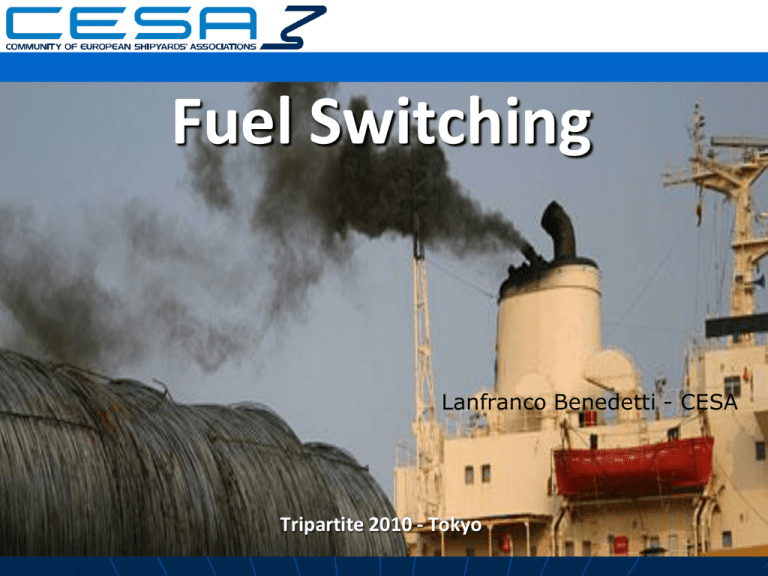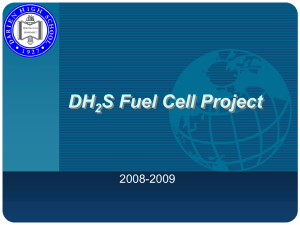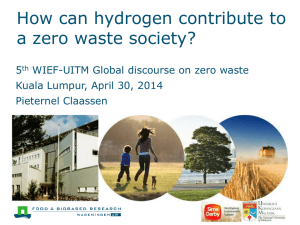Technical Issues
advertisement

Fuel Switching Lanfranco Benedetti - CESA Tripartite 2010 - Tokyo Some Regulations: (1) Article 4b of "EU COUNCIL DIRECTIVE 1999/32/EC of 26 April 1999 relating to a reduction in the sulphur content, introduces 0.1% sulphur limit (m/m) for marine fuel. a. Effective Date: January 1, 2010 b. Applies to: All types of marine fuel used by ships at berth for more than two hours in EU ports unless an approved emission abatement technology is employed or shore power is available (2) California Air Resources Board (CARB) a. Effective Dates: Phase I (in force) since July 1, 2009 (ISO 8217) at or below 1.5%S or (ISO 8217) at or below 0.5%S Phase II - January 1, 2012 (ISO 8217) at or below 0.1%S b. Applies to: All types of marine fuel used by ships within California Waters ………. Why Low Sulphur? First the chemical reaction Conversion Mechanism from Sulphur Dioxide to Suphuric acid Sulphur Trioxide and Sulphuric Acid in aerosol form damaging Health and Environment Second: Sulphur effect on us Allergen - Asthma Trigger - Respiratory (breathing) effects Constrict airways – Wheezing- Chest Tightness - Coughing Chronic exposure may cause Bronchitis High Concentrations can cause Severe Shortness of Breath Pulmonary Edema Fluid in the Lungs. Those most sensitive are children, the elderly Long-term exposure to low concentrations can cause headache, nausea and dizziness. Studies of workers exposed to high levels of sulfur dioxide have found increased risk for lung, stomach and brain cancer Exposure to increased levels from outdoor air pollution during pregnancy is associated with an increased risk for low birth weight and premature birth. Long term exposure may decrease fertility in males and females. Third: Sulphur effect on environment ACID RAINS effects on Forests ACID RAINS effects on our Cities What Policy Makers are asking to Maritime EU 01 1/4 What Policy Makers are asking to other sectors 2/4 AVIATION Currently, jet fuel has a specification maximum of 3,000 ppm for sulphur. However, jet fuel in the market has a lower sulphur content. Worldwide surveys conducted over the years found that annual weighted average jet fuel sulphur content ranged from 321-800 ppm. Hydrodesulphurization, which could be applied to remove the fuel sulphur, is a common process in petroleum refineries, and low sulphur diesel fuel is already widely used internationally. Low sulphur jet fuel has a sulphur content less than 15 ppm. What Policy Makers are asking to other sectors Land Based Transport “SECA” for Land Based Transport 3/4 Comparaisons 4/4 The strictest limit for shipping fuel, as of 2015 applicable in the Sulfur Emission Control Areas will still be 0,1%. The permissible sulfur content of diesel fuel for land based transport is limited to 10 ppm (i.e. 0,001%). The permissible sulfur content of aviation fuel is limited to 600 ppm (i.e. 0,06%) with a program for further reduction to 15 ppm (i.e. 0,0015%). That means ships will still be allowed to emit 100 times (!) more sulfur per fuel unit respect to land based transport. That means ships will still be allowed to emit still 2 times (!) more sulfur per fuel unit respect to air based transport in the short run and nearly 100 times more in the long term perspective. Technical Issues Low sulphur fuels Properties “made worse” Properties “improved” Density Aromatics & Naphthalenes Acidity Aromatics & Naphthalenes (for effect on aged fuel system elastomers) (for combustion properties) Specific Energy Lubricity Conductivity - Hydrogen content Copper Corrosion Water Separation Thermal stability (for continuous operation) - - Technical Issues Main problems identified on components like (but not only): Boilers Pumps Piping Cylinder Oils Storage Technical Issues In California, where fuel switching regulations have been in force since 1 July 2009, there were 15 reported casualty investigations attributed to fuel switching in the three months following implementation. The San Francisco Bar Pilots now say they have seen an incident every 1 – 3 days, involving engine failures, start failure whilst at berth and/or changes in speed which effect maneuverability. Technical Issues: Boilers - Usage Boilers are used on ships either for propulsion or as auxiliary services. Boilers for propulsion are used in combination with steam turbines but uncommon. Boilers are used for propulsion in ships that transport LNG. Cargo boil off during transport is used as fuel for the ship. For thermal efficiency, these boilers operate at high pressure of about 60 bar. Boil-off gas (BOG) is used for propulsion in combination with a liquid fuel. Technical Issues: Boilers - Problems Boilers that are constructed for the use of Heavy Fuel Oil (HFO) can in general not be used with Marine Gas Oil (MGO) without modifications. A switch from HFO to MGO in a boiler that is designed for HFO use could lead to operational problems with potential flame failure and an increased risk of a boiler explosion. Technical Issues: Boilers - Solutions Reports state that boiler explosions are due to defects or improper operations. (Flame out for some reason and a high pressure of fuel gas is built up in the burner and the control system is malfunctioning or disconnected). Proper procedures, training, and maintenance are essential for vessels to safely switch between heavy/intermediate fuel oils and marine distillates. Modification in burner management and associated control systems are needed (as flame failure detection). See also IMO subcommittee on bulk liquids (2007) Technical Issues: Piping - Problems The existing piping used to transport heated HFO from the pump to the boiler may not be suitable to transport MGO: (1) MGO needs to be delivered at ambient temperature (storage tank temperature – 40°) while HFO is delivered at 150°; (2) exists a concern that MGO flowing through hot piping may vaporize creating vapor locks and causing irregular fuel flow towards the burner resulting in flame extinction. The lighter the fuel, the easier the evaporation and the larger the risk for an air/fuel mix which is potentially unsafe. Therefore, MGO is not to be delivered through heated pipes to the burner. Technical Issues: Piping - Solutions In normal ship installations, "heat tracing" of pipes (by steam or electric heating) can be turned on or off. In this kind of installation, proper operation may be sufficient to avoid the risk of an explosion. In many cases, the operation of fuel switching is automatically handled by the ships' hardware and software. There are concerns that the crew on many ships may not be familiar with how to handle safely these situations. Proper instructions should be given. Consideration should be given to dedicated MGO delivery piping and accessories. The boilers do normally run on MGO during start up; however, at this point the system has not yet been heated. After the boiler pressure is up, the pipes can be emptied of MGO and then heated and used for HFO. MGO is thus not introduced to the boiler through heated pipes at this stage. Technical Issues: Pumps - Problems There is an increased risk of wear and pump breakdown if the oil has a higher viscosity and lower lubricity than what the pump is designed for. Extremely low sulphur content and consequent low viscosity levels have a strong impact on fuel injection and pump/valve lubrication There may be increased smoke emissions since the amount of fuel injected in the burner is set for HFO with a higher density and lower calorific value than MGO. When two different fuels are mixed there is a risk of incompatibility, which may cause clogging of fuel filters and separator, sticking of fuel injection pumps and considerable pump deterioration Technical Issues: Pumps - Solutions Screw pumps must be modified; Specially treated materials; Fuel pumps and valves may need to be replaced due to the different viscosity of the fuels; Pumps must be capable of handling low viscosity fuels while retaining the required pressures and capacities. Technical Issues: Cylinder Oils - Problems Cylinder oil used in large slow speed diesel engines is highly alkaline to counteract the acidic conditions produced when burning the more normal high sulphur fuel oil. The affect of using low sulphur fuel could lead to the situation where excess alkalinity occurs. Excess alkalinity could be as corrosive as excess acidity. Additives package not necessary when low sulphur fuels are used. Risk of metal to metal contact in the piston (rings/liner) and rapid wear due to additives deposit. Technical Issues: Cylinder Oils - Solutions The grade of cylinder oil should therefore be matched to the sulphur content of the fuel and both Owners and Engine Manufacturers may have to consider the possibility of dual cylinder oil systems. Technical Issues: Storage- Problems The problem of different grades of fuel could mean segregated storage tanks but it also raises the possibility of dual pumping systems etc. At the moment most ships do not have enough individual tanks to be able to keep some tanks just for low sulphur fuel for those few occasions when a vessel will be in a SECA. Charterers are also raising problems because if a vessel keeps certain tanks just for low sulphur fuel, they are not available to the Charterer to use for bunkering in low cost ports. Also if these segregated tanks are relatively small, they may not have the capacity to take the minimum quantity of a grade imposed at some ports with financial implications for Charterers. Technical Issues: Storage- Solutions One way round the problem of dual pumping systems would be to change over to low sulphur fuel early enough so that the transfer system and daily use tanks are flushed through before the vessel enters a SECA but this would have to be planned well in advance of entering a SECA. Regulation: Application Considerable justified uncertainty as to how, and to what extent, the Directive would be enforced after The Recommendation directs the 1 January deadline. Member States to enforce the Directive fully and completely as from 1 January 2010. However, the Recommendation also indicates to assess the appropriate The position beginning to penalty to be applied to nonemerge is that Member States complying vessels. are starting to enforce the Directive, in some cases reluctantly, but in some cases with gusto. Regulation: Application Some Italian ports have taken a harder line and Trieste, for example, will issue non-complaint In early April 2010, the United vessels burning higher sulphur Kingdom announced that it would fuels with fines of between be fully enforcing the Directive €15,000 and €150,000. from 20 April 2010. From this date, ships at berth in U.K. ports are not permitted to use bunker In contrast, authorities in France fuel exceeding the 0.1% limit. and Germany have confirmed that they will be applying the Directive, but do not appear to have offered a clear response or guidelines Conclusions Technical problems do exists Technical Solutions do exsist Investments are necessary but Investments, such as: •Implementing fuel saving measures; •Installing exhaust cleaning equipment ; •Switching to LNG as fuel. can decrease the fuel cost burden to a fraction by investing new ships or up-grading existing ones. Policy Makers should take appropriate action to facilitate the application of cleaner technologies . +++ Thank you for your attention +++ more info at http://www.cesa.eu





